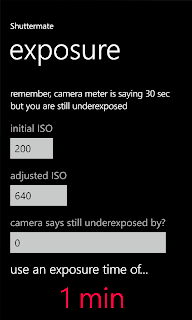I consider it a tool for landscape photographers. It contains a few different simple tools to help you with calculating exposure times or selecting the best filter to use. I do assume two things with this app. One, you use Aperture priority mode with your camera. Two, your camera is a Nikon DSLR. Now your camera doesn't strictly have to be a Nikon DSLR but some of the values you pick from in the tools may not apply to you or maybe your camera has more. I shoot with a Nikon D700 so I targeted everything for that camera.

nd filter
If you want to shoot at a target exposure say because you want to take a photograph of a waterfall and would like the water to be silky smooth with a 2.5 second exposure, you would use the 'nd filter' tool. Just put in your current exposure settings and your target exposure setting of 2.5 seconds and the app will tell you what ND filter density to use.
 dynamic range
dynamic rangeTaking a photograph that includes both a bright sky and a shadowy and darker foreground? The "dynamic range" tool will tell you the difference in stops between two exposure settings. Just put in your exposure setting for the sky and then another for the foreground and the app will tell you the dynamic range between the two. This may help you select the best ND graduated filter to use perhaps.

big stopper
Do you use a Lee Big Stopper or some other 10-stop ND filter? Use the 'big stopper' tool and put in your initial exposure before you use the filter and the app will tell you what your new exposure time will need to be when you use the filter.

long exposure
The last tool is one that helps you determine the correct long exposure time if you use the ISO bumping trick as I call it. I learned this trick from a one Bruce Percy while on a workshop with him. If you like to take photographs in low light like I do, say 30 minutes before sunrise or after sunset, most likely your camera won't meter properly and will stop at 30 seconds. At 30 seconds you will probably be underexposed. That's ok, just increase your ISO until the camera meters properly and tells you the scene is properly exposed. Now on my camera, the usable ISO ranges from 200 to 6400, that's 5-stops of dynamic range. If its too dark out, 5-stops may not be enough. Maybe time to break out the flashlights or call it a day? Anyhow, just enter in the initial ISO you started with and then the adjusted ISO and the app will tell you how long of an exposure you will need to take when using the initial ISO. Now on my D700, the display for the metering will also tell me if i'm -3EV or +3EV from a proper exposure. If you've hit the limit for your ISO and are still underexposed but maybe only by -3EV at the most, you can enter this value into the app and it will take it into consideration when telling you the proper exposure time.
That last tool does take a bit of explaining and its only useful in special circumstances. That's why its at the end of the list of tools. I don't use it very often but in the past when I needed this, I would have to perform some mental mathematical gymnastics to figure out my exposure time while the light was changing before my eyes! Working with fractional shutter speeds and exposure times is not exactly "easy" math if you ask me. So this is why I wrote this little app. No more mathematical mental gymnastics while out in the field. Now I can just concentrate on taking photographs and being creative and perhaps let that other half of my brain take a break.
